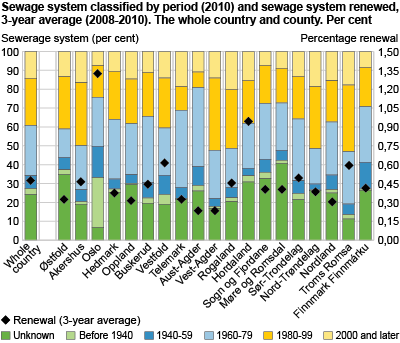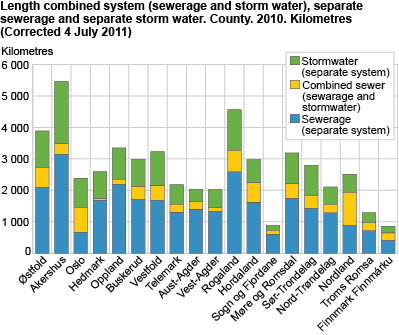Content
Published:
This is an archived release.
177 km of sewage system renewed
In 2010, 0.49 per cent, or 177 kilometres, of existing sewage pipeline system was renewed. Renewal of old pipelines was less than half the rate of installation of new wastewater pipelines, which was 1.22 per cent (441 kilometres). Total sewage pipelines are estimated at 36 100 kilometres.
Unless renewal increases to a higher level, this will unavoidably lead to aging wastewater pipelines throughout the municipalities. Even without new installations, it will take more than 200 years to renew the whole pipeline system, given the current renewal rate.
Highest renewal rates in Oslo and Hordaland
Renewals tend to vary from one year to another. The key figure “Percentage of total sewage pipeline system renewed, 3-year average” will even out these cyclical variations.
For the 3-year period 2008-2010, the municipalities in the counties of Oslo (1.38 per cent), Hordaland (1.00 per cent) and Vestfold (0.67 per cent) renewed the most, while Vest-Agder (0.29 per cent), Aust-Agder (0.29 per cent) and Nordland (0.36) renewed the least.
Of 398 reporting municipalities (430 in total), 39 per cent reported that at least part of the sewage pipeline system has been renewed, 12 per cent specified no renewal and 49 per cent were non-respondents. Corresponding figures on installation of new pipelines were 50, 23 and 27 respectively.
| Year | |||||||||||||||||||||||||||||||||||||||||||||||||||||||||||||||||||||||||||||||
|---|---|---|---|---|---|---|---|---|---|---|---|---|---|---|---|---|---|---|---|---|---|---|---|---|---|---|---|---|---|---|---|---|---|---|---|---|---|---|---|---|---|---|---|---|---|---|---|---|---|---|---|---|---|---|---|---|---|---|---|---|---|---|---|---|---|---|---|---|---|---|---|---|---|---|---|---|---|---|---|
| 2004 | 2005 | 2006 | 2007 | 2008 | 2009 | 2010 | |||||||||||||||||||||||||||||||||||||||||||||||||||||||||||||||||||||||||
| Number of municipalities reported | 427 | 392 | 401 | 386 | 386 | 405 | 398 | ||||||||||||||||||||||||||||||||||||||||||||||||||||||||||||||||||||||||
| Per cent | |||||||||||||||||||||||||||||||||||||||||||||||||||||||||||||||||||||||||||||||
| Per cent of municipalities responded more than nill metres renewed | 41.0 | 44.1 | 41.4 | 37.3 | 36.8 | 38.0 | 39.4 | ||||||||||||||||||||||||||||||||||||||||||||||||||||||||||||||||||||||||
| Per cent of municipalities responded nill metres renewed | 44.7 | 23.0 | 25.4 | 17.4 | 14.5 | 25.2 | 11.8 | ||||||||||||||||||||||||||||||||||||||||||||||||||||||||||||||||||||||||
| Per cent municipalities responded blank on metres renewed | 14.3 | 32.9 | 33.2 | 45.3 | 48.7 | 36.8 | 48.7 | ||||||||||||||||||||||||||||||||||||||||||||||||||||||||||||||||||||||||
The renewal of sewage pipelines is of critical importance to preventing damage to buildings and pollution through leakages. Leaking sewage pipelines can also contribute to higher treatment costs as surface water and groundwater can enter the pipelines.
Akershus and Rogaland have the longest sewage system
Estimations for 2010 show that there were around 36 100 kilometres of municipal sewage pipelines in the whole country (not including separate storm water pipelines), which is equal to approximately 90 per cent of the circumference of the earth at the equator. The sewage pipelines can be divided into 7 700 kilometres of combined sewage and storm water and 28 400 kilometres of a separate sewage system. The municipalities in the counties of Akershus and Rogaland hold the longest sewage system, while counties in Oslo and Nordland have the largest share of combined sewer systems.
In addition to the 36 100 kilometres of sewage systems, there is also an additional 15 200 kilometres of separate storm water pipelines. Hence, around 51 300 kilometres of municipal wastewater pipelines exist in Norway in total.
39 per cent less than 30 years old
A total of 3.1 per cent of the municipal wastewater pipelines were installed before 1940, while 39 per cent were installed in 1980 or later. Due to changes in the questionnaire, a large share of pipelines reported last year as laid in 1980 or later was put in the category “age unknown” this year; a category that has increased from 10 per cent in 2009 to 24 per cent in 2010. Thus, it is expected that a large part of this reported increase of 14 percentage points actually belongs in the category 1980 or later, and that this category probably levels up closer to last year’s 51 per cent.
In 2010 the renewal rates were highest for the oldest part of the sewage system, with 0.81 per cent renewal for the pipelines laid before 1940. By comparison, there was a 0.19 per cent renewal of sewage pipelines installed in 1980 or later.
One pumping station every four kilometres
Pumping stations are sometimes used to direct wastewater against gravity (uphill etc). For 2010 it has been estimated that there are around 8 900 municipally-owned pumping stations in Norway; an average density of 0.25 pumping stations per kilometre.
Variation in standard of sewerage pipeline systems
An estimate of 2 700 sewage overflows in 2010 has occurred throughout the country. This corresponds to 75 sewage overflows per thousand kilometre of municipal pipeline system - a 17 and 13 per cent decrease compared to 2009 and 2008 respectively.
Sewage overflows may be related to the age of the pipeline systems, but differences in this year’s dataset are not significant enough to be conclusive. In municipalities where the average age was below 25 years, the figure was 76 sewage overflows per thousand kilometre of pipelines, while this figure was 79 in municipalities for pipelines older than 50 years.
85 per cent of inhabitants connected to wastewater facilities of 50 pe or more
For 2010, it has been estimated that slightly less than 85 per cent of inhabitants are connected to municipal wastewater facilities of 50 person equivalents (pe) or more. Private solutions are most common among wastewater facilities less than 50 pe. The -2.4 per cent deviation between reported data on inhabitants connected and official population statistics - shown in the table - reflects the uncertainty in the reported data for inhabitants connected.
| Number of inhabitants | Percentage | ||||||||||||||||||||||||||||||||||||||||||||||||||||||||||||||||||||||||||||||
|---|---|---|---|---|---|---|---|---|---|---|---|---|---|---|---|---|---|---|---|---|---|---|---|---|---|---|---|---|---|---|---|---|---|---|---|---|---|---|---|---|---|---|---|---|---|---|---|---|---|---|---|---|---|---|---|---|---|---|---|---|---|---|---|---|---|---|---|---|---|---|---|---|---|---|---|---|---|---|---|
| 2010 | 2009 | 2008 | 2010 | ||||||||||||||||||||||||||||||||||||||||||||||||||||||||||||||||||||||||||||
| Number of inhabitants connected to wastewater treatment plants 50 pe or more | 4 064 210 | 3 996 481 | 3 915 791 | 84.6 | |||||||||||||||||||||||||||||||||||||||||||||||||||||||||||||||||||||||||||
| whereof connected to municipal wastewater treatment plants | 4 033 217 | 3 965 562 | 3 882 773 | 84.0 | |||||||||||||||||||||||||||||||||||||||||||||||||||||||||||||||||||||||||||
| whereof connected to non-municipal wastewater treatment plants | 30 993 | 30 919 | 33 018 | 0.6 | |||||||||||||||||||||||||||||||||||||||||||||||||||||||||||||||||||||||||||
| Number of inhabitants connected to wastewater treatment plants less than 50 pe or more | 739 022 | 753 290 | 765 675 | 15.4 | |||||||||||||||||||||||||||||||||||||||||||||||||||||||||||||||||||||||||||
| whereof connected to municipal wastewater treatment plants | 77 716 | 90 483 | 121 157 | 1.6 | |||||||||||||||||||||||||||||||||||||||||||||||||||||||||||||||||||||||||||
| whereof connected to non-municipal wastewater treatment plants | 661 306 | 662 807 | 644 518 | 13.8 | |||||||||||||||||||||||||||||||||||||||||||||||||||||||||||||||||||||||||||
| Total number of inhabitants reported connected | 4 803 232 | 4 749 771 | 4 681 466 | 100.0 | |||||||||||||||||||||||||||||||||||||||||||||||||||||||||||||||||||||||||||
| For comparison: official population statistics 1. Jan subsequent year | 4 920 305 | 4 858 199 | 4 799 252 | 102.4 | |||||||||||||||||||||||||||||||||||||||||||||||||||||||||||||||||||||||||||
| Deviation between connection to municipal wastewater plants and official population statistics | -117 073 | -108 428 | -117 786 | -2.4 | |||||||||||||||||||||||||||||||||||||||||||||||||||||||||||||||||||||||||||
Different types of wastewater pipeline systemsThere are three main groups of wastewater pipeline systems: (1) Combined sewer (both sewerage and storm water) (2) Separate sewerage (3) Separate storm water What is referred to as sewerage pipeline system in this article includes only the two first categories, while separate storm water system and private house connections are excluded. |
The statistics is now published as Municipal wastewater.
Contact
-
Gisle Berge
E-mail: gisle.berge@ssb.no
tel.: (+47) 48 12 19 97


